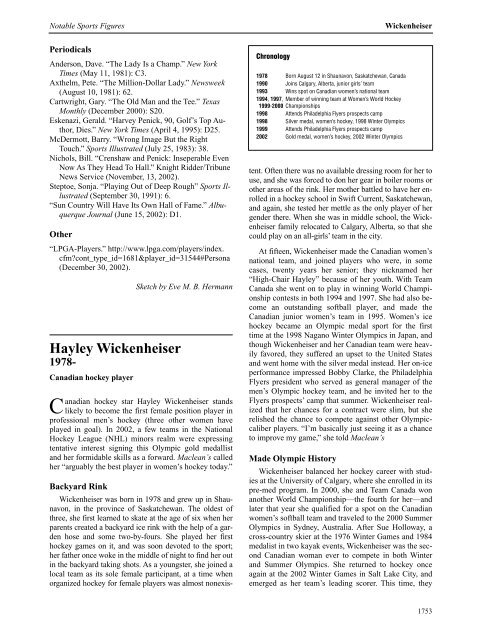Frank Thomas
Frank Thomas
Frank Thomas
Create successful ePaper yourself
Turn your PDF publications into a flip-book with our unique Google optimized e-Paper software.
Notable Sports Figures<br />
Periodicals<br />
Anderson, Dave. “The Lady Is a Champ.” New York<br />
Times (May 11, 1981): C3.<br />
Axthelm, Pete. “The Million-Dollar Lady.” Newsweek<br />
(August 10, 1981): 62.<br />
Cartwright, Gary. “The Old Man and the Tee.” Texas<br />
Monthly (December 2000): S20.<br />
Eskenazi, Gerald. “Harvey Penick, 90, Golf’s Top Author,<br />
Dies.” New York Times (April 4, 1995): D25.<br />
McDermott, Barry. “Wrong Image But the Right<br />
Touch.” Sports Illustrated (July 25, 1983): 38.<br />
Nichols, Bill. “Crenshaw and Penick: Inseperable Even<br />
Now As They Head To Hall.” Knight Ridder/Tribune<br />
News Service (November, 13, 2002).<br />
Steptoe, Sonja. “Playing Out of Deep Rough” Sports Illustrated<br />
(September 30, 1991): 6.<br />
“Sun Country Will Have Its Own Hall of Fame.” Albuquerque<br />
Journal (June 15, 2002): D1.<br />
Other<br />
“LPGA-Players.” http://www.lpga.com/players/index.<br />
cfm?cont_type_id=1681&player_id=31544#Persona<br />
(December 30, 2002).<br />
Hayley Wickenheiser<br />
1978-<br />
Canadian hockey player<br />
Sketch by Eve M. B. Hermann<br />
Canadian hockey star Hayley Wickenheiser stands<br />
likely to become the first female position player in<br />
professional men’s hockey (three other women have<br />
played in goal). In 2002, a few teams in the National<br />
Hockey League (NHL) minors realm were expressing<br />
tentative interest signing this Olympic gold medallist<br />
and her formidable skills as a forward. Maclean’s called<br />
her “arguably the best player in women’s hockey today.”<br />
Backyard Rink<br />
Wickenheiser was born in 1978 and grew up in Shaunavon,<br />
in the province of Saskatchewan. The oldest of<br />
three, she first learned to skate at the age of six when her<br />
parents created a backyard ice rink with the help of a garden<br />
hose and some two-by-fours. She played her first<br />
hockey games on it, and was soon devoted to the sport;<br />
her father once woke in the middle of night to find her out<br />
in the backyard taking shots. As a youngster, she joined a<br />
local team as its sole female participant, at a time when<br />
organized hockey for female players was almost nonexis-<br />
Chronology<br />
1978 Born August 12 in Shaunavon, Saskatchewan, Canada<br />
1990 Joins Calgary, Alberta, junior girls’ team<br />
1993 Wins spot on Canadian women’s national team<br />
1994, 1997, Member of winning team at Women’s World Hockey<br />
1999-2000 Championships<br />
1998 Attends Philadelphia Flyers prospects camp<br />
1998 Silver medal, women’s hockey, 1998 Winter Olympics<br />
1999 Attends Philadelphia Flyers prospects camp<br />
2002 Gold medal, women’s hockey, 2002 Winter Olympics<br />
tent. Often there was no available dressing room for her to<br />
use, and she was forced to don her gear in boiler rooms or<br />
other areas of the rink. Her mother battled to have her enrolled<br />
in a hockey school in Swift Current, Saskatchewan,<br />
and again, she tested her mettle as the only player of her<br />
gender there. When she was in middle school, the Wickenheiser<br />
family relocated to Calgary, Alberta, so that she<br />
could play on an all-girls’ team in the city.<br />
At fifteen, Wickenheiser made the Canadian women’s<br />
national team, and joined players who were, in some<br />
cases, twenty years her senior; they nicknamed her<br />
“High-Chair Hayley” because of her youth. With Team<br />
Canada she went on to play in winning World Championship<br />
contests in both 1994 and 1997. She had also become<br />
an outstanding softball player, and made the<br />
Canadian junior women’s team in 1995. Women’s ice<br />
hockey became an Olympic medal sport for the first<br />
time at the 1998 Nagano Winter Olympics in Japan, and<br />
though Wickenheiser and her Canadian team were heavily<br />
favored, they suffered an upset to the United States<br />
and went home with the silver medal instead. Her on-ice<br />
performance impressed Bobby Clarke, the Philadelphia<br />
Flyers president who served as general manager of the<br />
men’s Olympic hockey team, and he invited her to the<br />
Flyers prospects’ camp that summer. Wickenheiser realized<br />
that her chances for a contract were slim, but she<br />
relished the chance to compete against other Olympiccaliber<br />
players. “I’m basically just seeing it as a chance<br />
to improve my game,” she told Maclean’s<br />
Made Olympic History<br />
Wickenheiser<br />
Wickenheiser balanced her hockey career with studies<br />
at the University of Calgary, where she enrolled in its<br />
pre-med program. In 2000, she and Team Canada won<br />
another World Championship—the fourth for her—and<br />
later that year she qualified for a spot on the Canadian<br />
women’s softball team and traveled to the 2000 Summer<br />
Olympics in Sydney, Australia. After Sue Holloway, a<br />
cross-country skier at the 1976 Winter Games and 1984<br />
medalist in two kayak events, Wickenheiser was the second<br />
Canadian woman ever to compete in both Winter<br />
and Summer Olympics. She returned to hockey once<br />
again at the 2002 Winter Games in Salt Lake City, and<br />
emerged as her team’s leading scorer. This time, they<br />
1753

















